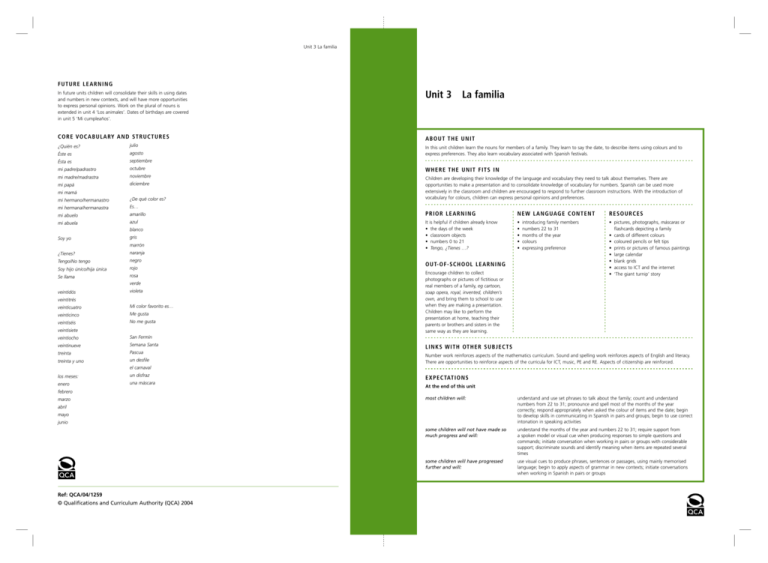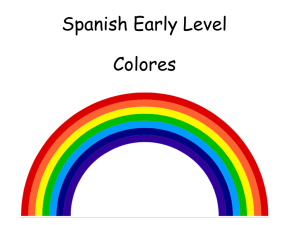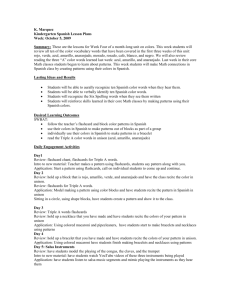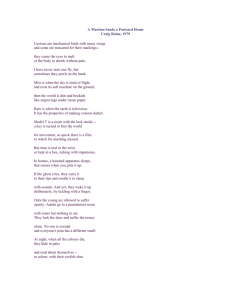Unit 3 La familia
advertisement

Unit 3 La familia FUTURE LEARNING In future units children will consolidate their skills in using dates and numbers in new contexts, and will have more opportunities to express personal opinions. Work on the plural of nouns is extended in unit 4 ‘Los animales’. Dates of birthdays are covered in unit 5 ‘Mi cumpleaños’. Unit 3 La familia C O R E VO C A BU L A RY A N D S T RU C T U R E S ABOUT THE UNIT ¿Quién es? julio Éste es agosto Ésta es septiembre mi padre/padrastro octubre WHERE THE UNIT FITS IN mi madre/madrastra noviembre mi papá diciembre Children are developing their knowledge of the language and vocabulary they need to talk about themselves. There are opportunities to make a presentation and to consolidate knowledge of vocabulary for numbers. Spanish can be used more extensively in the classroom and children are encouraged to respond to further classroom instructions. With the introduction of vocabulary for colours, children can express personal opinions and preferences. mi mamá In this unit children learn the nouns for members of a family. They learn to say the date, to describe items using colours and to express preferences. They also learn vocabulary associated with Spanish festivals. mi hermano/hermanastro ¿De qué color es? mi hermana/hermanastra Es… mi abuelo amarillo PRIOR LEARNING N E W L A N G UAG E C O N T E N T RESOURCES mi abuela azul It • • • • • • • • • • pictures, photographs, máscaras or flashcards depicting a family • cards of different colours • coloured pencils or felt tips • prints or pictures of famous paintings • large calendar • blank grids • access to ICT and the internet • ‘The giant turnip’ story blanco Soy yo gris marrón ¿Tienes? naranja Tengo/No tengo negro Soy hijo único/hija única rojo Se llama rosa verde veintidós violeta veintitrés veinticuatro Mi color favorito es… veinticinco Me gusta veintiséis No me gusta veintisiete veintiocho San Fermín veintinueve Semana Santa treinta Pascua treinta y uno un desfile is helpful if children already know the days of the week classroom objects numbers 0 to 21 Tengo, ¿Tienes …? O U T- O F - S C H O O L L E A R N I N G Encourage children to collect photographs or pictures of fictitious or real members of a family, eg cartoon, soap opera, royal, invented, children’s own, and bring them to school to use when they are making a presentation. Children may like to perform the presentation at home, teaching their parents or brothers and sisters in the same way as they are learning. introducing family members numbers 22 to 31 months of the year colours expressing preference L I N K S W I T H OT H E R S U B J E C T S Number work reinforces aspects of the mathematics curriculum. Sound and spelling work reinforces aspects of English and literacy. There are opportunities to reinforce aspects of the curricula for ICT, music, PE and RE. Aspects of citizenship are reinforced. el carnaval los meses: un disfraz enero una máscara E X P E C TAT I O N S At the end of this unit febrero marzo most children will: understand and use set phrases to talk about the family; count and understand numbers from 22 to 31; pronounce and spell most of the months of the year correctly; respond appropriately when asked the colour of items and the date; begin to develop skills in communicating in Spanish in pairs and groups; begin to use correct intonation in speaking activities some children will not have made so much progress and will: understand the months of the year and numbers 22 to 31; require support from a spoken model or visual cue when producing responses to simple questions and commands; initiate conversation when working in pairs or groups with considerable support; discriminate sounds and identify meaning when items are repeated several times some children will have progressed further and will: use visual cues to produce phrases, sentences or passages, using mainly memorised language; begin to apply aspects of grammar in new contexts; initiate conversations when working in Spanish in pairs or groups abril mayo junio Ref: QCA/04/1259 © Qualifications and Curriculum Authority (QCA) 2004 Unit 3 La familia LEARNING OBJECTIVES P O S S I B L E T E AC H I N G AC T I V I T I E S LEARNING OUTCOMES P O I N T S TO N OT E CHILDREN CHILDREN SHOULD LEARN Section 1. Talking about the family • to introduce members of their family • Introduce the words for members of the family using pictures, prints of paintings, flashcards or a family tree. • Take the example of a fictitious, historical or famous family. Use flashcard masks to introduce the family and ask ¿Quién es? to elicit the response Es el hermano. • Introduce a finger rhyme for the family starting with the thumb: Este chiquito es mi hermano. Ésta es mi mamá. Este alto es mi papá. Ésta es mi hermana. Y este chiquito y bonito soy yo. (As this is a traditional rhyme mamá and papá are used. Explain the link with madre and padre.) • Ask children about brothers and sisters, eg Tengo un hermano. ¿Y tú? ¿Tienes hermanos? Sí, tengo un hermano. No, no tengo hermanos. • Introduce the question ¿Cómo se llama? Allow one word responses, while encouraging children to use short phrases, eg Se llama Paul. • Give children cards with details of famous families. The children each choose which member of the family they are and the rest of the class ask questions: ¿Cómo te llamas? ¿Cuántos años tienes? etc. The children respond Me llamo Brooklyn. Tengo dos años. Whichever group guesses the identity of the family gets the points and is the next team to be the famous family. ▲ Extend to ¿Tienes una hermana? Sí, tengo una hermana. Se llama Susan. Tiene ocho años y vive en St Helens. ▲ Introduce mi, mis. Children could make a family tree of a famous, historical or imaginary family. They could use photographs or pictures of each member and copy or write short descriptions for each one, eg Éste es mi hermano. Se llama Richard. ▲ Children present their family tree to a partner or to a small group. Some children may need to use their written work for support. If the phrases are written out and displayed around the room, children can be encouraged to refer to these for support. Other children should be encouraged to use just the picture as a visual cue. ▲ Introduce the story of ‘The giant turnip’ to reinforce the family members. Children can act out the story in Spanish and produce their own ‘Big book’. This will develop skills in literacy, art and ICT. • identify correctly names for members of the family • understand and say whether or not they have brothers and sisters, eg Tengo un hermano/una hermana. No tengo hermanos/hermanas • respond with Se llama James when asked someone’s name • say a finger rhyme introducing the family • role-play members of an imaginary or famous family, eg Éste es mi padre. Ésta es mi madre • use visual cues to produce short phrases using mainly memorized language • Use a fictitious, historical or soap opera family as a model to present and practise family vocabulary. Sensitivity will be needed if you decide to question children about their own families. Flashcards of families from Spanish-speaking countries such as Peru and Cuba can be used to show the diverse cultures in the Spanish-speaking world, thus reinforcing the citizenship curriculum. • You may wish to introduce words for other family members such as abuelo, abuela. • When using someone else’s family as a model, children can either take on a role and say Mi padre se llama… or say Es el hermano de… • Children may have met family trees in other contexts, eg historical figures or characters from a novel. This activity provides an opportunity to reinforce knowledge of how a family tree is constructed. • Compare ways in which positive statements are changed into negatives in Spanish and English (NLS year 4). • Revise vocabulary for numbers 13 to 21 and introduce 22 to 31. Play numeracy games such as those described in unit 2 section 1. • Revise vocabulary for the days of the week using whole-class games. For example, sing lunes martes etc. to the tune of ‘Camptown Races’; ask the questions ¿Qué día es hoy? ¿Qué día fue ayer? and ¿Qué día será mañana? Play sequencing game with the days of the week flashcards. • Introduce the months using flashcards showing the month in Spanish and a symbol (weather or festival) to denote that month. Play sequencing and guessing games with the cards. Sing San Fermín to reinforce the months up to July and also to show an aspect of Spanish culture. • Mention important dates such as El día de Reyes and discuss how Christmas is different in Spain, thus reinforcing aspects of citizenship and of the RE curriculum. • Reinforce weather vocabulary and ask ¿Qué tiempo hace en febrero? • Gradually introduce the question ¿Qué fecha es hoy? Use a large calendar, giving children plenty of opportunities to practise combining the day, date and current month. • As a listening exercise, read out a number of dates. Ask the children to pick out today’s date heard from a given list. Provide the list on the board and ask children to copy down the item they hear. For more support, give children their own copy of the list on paper and ask them to circle the correct answers. • Children work in pairs to play ‘Date battleships’ as an information gap activity. Child A will have a list of (eg January) dates and a grid with some blanks. Child B will have a list of the dates that correspond to A’s blanks and vice versa. Children take turns to question each other, using the letter and number of a square, eg A4 ¿Quince de enero? They respond Sí, A4 quince de enero or No, no es. • Divide the class into two groups: Argentina and Venezuela or Chicos and Chicas. The teacher writes ten dates in number form, eg A. 15/12; B. 7/7, etc. The children from one group ask ¿Qué fecha es A? The other group have to reply el quince de diciembre to win a point. • understand and use numbers 1 to 31 actively and out of sequence • understand dates when these are spoken • say the date when asked, eg Es lunes, trece de febrero or Es el trece de febrero • communicate in pairs, using cues to help them initiate and respond • Make children aware of the predictability of the pattern after number 20 and of similarities in number patterns with English and other languages. • When introducing the months, point out the pronunciation of junio, julio and marzo. • Point out that days and months are written entirely in lower case in Spanish. This will need some emphasis, as children will be familiar with the use of initial capital letters in the English equivalents. • Ask a volunteer to write the date on the board every day. • For the listening activity some children will be able to write down what they hear with no visual support. • After the listening activity, children could swap papers and mark each other’s work or mark their own using a different coloured pencil. • For the ‘Battleships’ activity some children will need visual cues on their grid to help them remember how to phrase the question. It may be better to work with lower numbers and one familiar-sounding month such as mayo. Other children should be encouraged to create their own grids, increasing the random factor and using the full range of dates and months. Section 2. Saying the date • to say today’s date Continued over Unit 3 La familia LEARNING OBJECTIVES P O S S I B L E T E AC H I N G AC T I V I T I E S CHILDREN SHOULD LEARN LEARNING OUTCOMES P O I N T S TO N OT E CHILDREN Section 3. Celebrating festivals abroad • about festivals celebrated in Spain and South America • Reinforce the months up to July by singing San Fermín. This will also show an aspect of Spanish culture. Discuss the running of the bulls and compare this with sports such as foxhunting. • Mention important dates such as El Día de Reyes and discuss how Christmas is different in Spain, thus reinforcing aspects of citizenship and of the RE curriculum. Discuss the fact that in Spain the Three Wise Men, not Father Christmas, bring gifts. • Show a video of a Holy Week procession. Compare with the way we celebrate Easter in Great Britain. • learn a Spanish song and are introduced to Spanish festivals and culture • Depending on the time of year, other festivals such as New Year’s Eve, Halloween, Valentine’s Day and Bonfire Night could be considered. Bonfire Night could be compared to Las Fallas in Valencia. • Children could exchange greetings cards with their link school at Easter and Christmas. • As a comparison, children from other ethnic backgrounds could describe the way they celebrate their festivals. • Introduce vocabulary for colours with flashcards or a large picture of a rainbow, giving plenty of opportunities for repetition. Use song to reinforce the colours. For example, to the tune of ‘Here we go gathering nuts in May’ sing: Blanco, rojo, verde, azul, verde azul, verde, azul. Blanco, rojo, verde, azul, verde azul. To the tune of clock chimes (ding dong, ding dong, etc.) sing: Rosa, lila, rosa, lila. Marrón, naranja, marrón, naranja. To the tune of ‘Frère Jacques’ sing: Amarillo, amarillo. Amarillo, amarillo. Negro, amarillo. Negro, amarillo. Amarillo, amarillo. Ask some children to come to the front of the class. Give each of them a colour flashcard and ask them to raise their card as the colour is mentioned during a song. Then ask a confident child to volunteer to play the part of the teacher. The child holds all four colour flashcards and tries to show the correct colour as the other children sing. Encourage the children to make up their own colours song, using any suitable tune. Gradually introduce the question ¿De qué color es? to elicit the response Es rojo. • Introduce ¿Te gusta el azul? to elicit the response Me gusta el azul or No me gusta el azul. Develop this by adding the question ¿Cuál es tu color favorito? ¿Te gusta el amarillo? to elicit the response Mi color favorito es el rojo and No me gusta el amarillo. • Play a game with the flashcards asking ¿Qué tengo en la mano? Children have to guess the colour in your hand. • Play a ‘Telepathy game’. Ask children to guess which colour you are thinking of, using the phrase Pienso en un color. ¿Qué color es? to elicit the response ¿Es el verde? Play the game at speed, responding with a simple No, no es el verde for wrong answers. • Once children are confident using the vocabulary for colours, consolidate the use of the adjectives by combining them with a classroom item, eg Muéstrame un lápiz azul, expecting the children to respond appropriately. Increase the level of difficulty by widening the range and number of items and colours. • Introduce children to the different sounds of the colour adjectives when applied to feminine nouns, eg un bolígrafo rojo compared to una tiza roja. Stress the effect on pronunciation and spelling. Ask the children to match the appropriate text flashcard to the item. Use blue card for masculine and pink for feminine. Those which do not change should be on white card. • As a listening activity, read out names of objects with colour adjectives after them. The children make a very quick coloured sketch to show they understand, eg Tengo un lápiz verde. ¿Tienes un libro blanco? They could be asked to correct each other’s work and call out their score in the target language, eg Dadme las notas por favor. • Ask the children the colours of the shirts of famous football teams, eg ¿De qué color es la camiseta del Real Madrid? eliciting Es blanca. • Play a guessing game ‘What’s in the bag?’ Bring a bag of coloured items and ask ¿Qué hay en la bolsa? • say the colour in response to a visual cue or a question, eg ¿Qué color es? Es rojo • use short phrases to express personal preferences, eg No me gusta el azul. Me gusta el rojo • show they understand nouns used with colours • show they understand simple commands by responding appropriately • discriminate sounds and identify meaning • When introducing the colours, emphasise and practise the pronunciation of rojo, amarillo, azul and verde. • Substitute single words in songs, such as the words for colours. • Compare the position of colour adjectives in English and Spanish, eg a yellow book – un libro amarillo. Point out that colour adjectives in Spanish go after the noun. • There are plenty of opportunities for children to consolidate their understanding of the position of the adjective in further reading and writing tasks. For example, give children a short passage containing a description of the contents of a school bag. Ask children to substitute text with appropriate pictures to complete sentences. Children could copy the phrases correctly or write short sentences describing the contents of their own school bag. • Prints of famous paintings can be used to introduce vocabulary for colours, family members. • Draw attention to Spanish paintings of specific styles and periods and discuss them in English. • Ask the children what happens when colours are mixed, eg ¿Azul y amarillo? – verde. ¿Rojo y amarillo? – naranja. • Games like ‘Simón dice’, ‘Paircards’ and ‘Bingo’ can be played at any point during the day to consolidate vocabulary, including adjectives. • Another activity to practise colours, best played in the hall where there is more space, is the ‘Four corners’ game. Go into the hall and place one of four colours in each corner. The children get in a circle and sing Blanco, rojo, verde, azul. At the end of the song you clap and the children have to pick a corner and go to it. You pull a colour out of the bag. If you pick azul, everyone in the blue corner is out. Those remaining have to do what you say, eg cantad San Fermín, contad hasta treinta y uno, saltad diez veces, levantaos y sentaos cinco veces, etc. PE can be linked to this activity by introducing different forfeits, eg saltad quince veces, saltad a la pata coja cinco veces, corred, etc. Using the school hall or playground for action games and activities in Spanish makes learning fun and memorable. Section 4. Colours • to describe items using vocabulary for colours • to express likes and dislikes (with reference to colours) Continued over LEARNING OBJECTIVES P O S S I B L E T E AC H I N G AC T I V I T I E S LEARNING OUTCOMES P O I N T S TO N OT E CHILDREN CHILDREN SHOULD LEARN Section 5. Sounds and spelling • about sounds and the spellings of certain words • how to form the plural of nouns • Revise work on sounds from unit 2 by drawing out specific sounds of new words introduced in this unit, eg – trece, hace, diciembre – feliz, marzo, azul, lápiz, pizarra – jueves, junio, julio, rojo, gigante – llamo, amarillo, silla – viernes, ventana, nabo – español, cumpleaños, año – quince, quién, qué – veinte, treinta – chico, estuche. • Revise the spelling of words from unit 2. Consolidate by adding more familiar words from this unit. • Point out to children the sound/spelling rule for the plural of nouns: add an -s to nouns ending in a vowel, and -es to nouns ending in a consonant, eg un hermano, dos hermanos; una silla, dos sillas; un ordenador, dos ordenadores. ▲ Make up poems using rhyming words. This can be quite a simple activity, for example using words with the same number of syllables, eg Madre, padre. Inglés, gales. Rosa, lila. Abre, cierra. (This is an example of an acrostic poem making the word mira, meaning ‘look’.) • recognise sounds when they hear them • produce the written form of certain sounds and spoken words • pick out from a short written text words that rhyme/contain the same sound • recognise familiar words when spelt out, and write them down • These activities do not need to be discrete items. They can be integrated with the other suggested activities as and when you feel it is appropriate. • Children will be familiar with recognising sound patterns (such as words that rhyme or words that contain the same sound) in words in English (NLS years 2, 3). • As children become more confident using the alphabet, encourage them to respond to the question ¿Cómo se escribe? • take part in brief prepared tasks, using visual cues to help them • write short sentences on familiar topics • use Spanish for real purposes • If the school has a Spanish-speaking partner school, the text and presentation can be e-mailed or posted and information exchanged. END-OF-UNIT ACTIVITIES • to apply the knowledge, skills and understanding learnt in this unit • Children copy out, adapt a model or write a short text about themselves or a famous person. They include details such as name, age and where they live and possibly introduce family members. They could use a word processor to redraft work. • Children could make short presentations to others, using their own texts for support. They could use a multimedia package to improve the quality of the presentation. They could record the presentation on video or audio cassette. • Children could perform ‘The giant turnip’ for the rest of the school or for parents. This could be recorded on video. Unit 3 La familia








